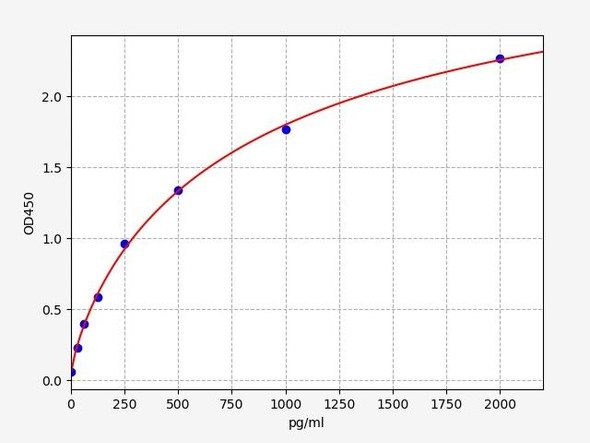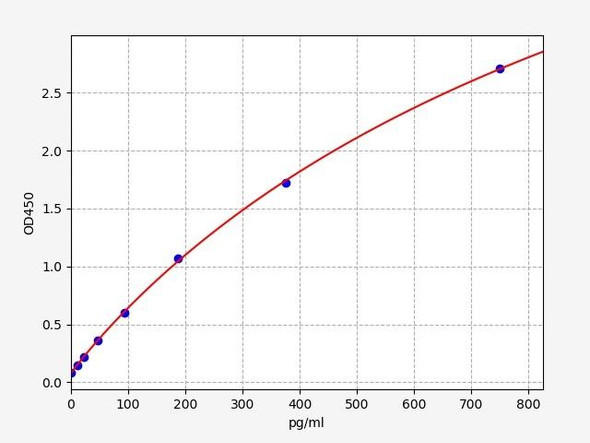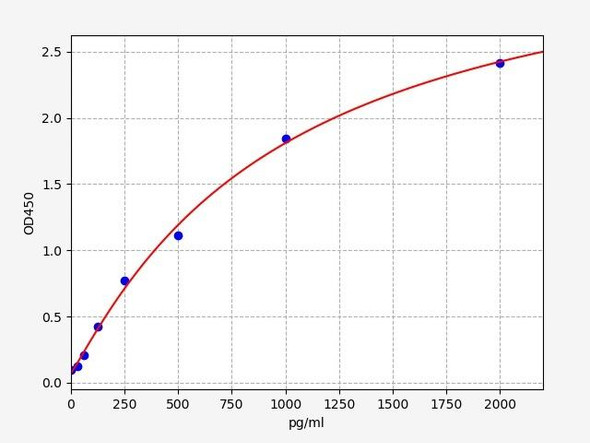Human IL-12 p40 ELISA Kit (HUES01425)
- SKU:
- HUES01425
- Product Type:
- ELISA Kit
- Size:
- 96 Assays
- Uniprot:
- P29460
- Sensitivity:
- 18.75pg/mL
- Range:
- 31.25-2000pg/mL
- ELISA Type:
- Sandwich
- Synonyms:
- IL12B, IL-12B, CLMF2, NKSF2, p40, IL-12/IL-23 p40
- Reactivity:
- Human
- Sample Type:
- Serum, plasma and other biological fluids
- Research Area:
- Cell Biology
Description
Human IL-12 p40 ELISA Kit
The Human IL-12 p40 ELISA Kit is specifically designed for the precise measurement of IL-12 p40 levels in human serum, plasma, and cell culture supernatants. This kit offers exceptional sensitivity and specificity, guaranteeing accurate and consistent results for various research purposes.IL-12 p40 is a key cytokine involved in the immune response, playing a critical role in regulating inflammation and immune cell activation. Dysregulation of IL-12 p40 has been linked to various autoimmune diseases, infectious diseases, and inflammatory conditions, making it a valuable biomarker for studying these diseases and potential therapeutic interventions.
With its high-quality components and user-friendly protocol, the Human IL-12 p40 ELISA Kit from AssayGenie is an essential tool for researchers looking to investigate the role of IL-12 p40 in health and disease.
| Assay type: | Sandwich |
| Format: | 96T |
| Assay time: | 4.5h |
| Reactivity: | Human |
| Detection Method: | Colormetric |
| Detection Range: | 31.25-2000 pg/mL |
| Sensitivity: | 18.75 pg/mL |
| Sample Volume Required Per Well: | 100µL |
| Sample Type: | Serum, plasma and other biological fluids |
| Specificity: | This kit recognizes Human IL12 p40 ELISA Kit in samples. No significant cross-reactivity or interference between Human IL12 p40 ELISA Kit and analogues was observed. |
This ELISA kit uses Sandwich-ELISA as the method. The micro ELISA plate provided in this kit has been pre-coated with an antibody specific to Human IL12p40. Standards or samples are added to the appropriate micro ELISA plate wells and combined with the specific antibody. Then a biotinylated detection antibody specific for Human IL12p40 and Avidin-Horseradish Peroxidase (HRP) conjugate are added to each micro plate well successively and incubated. Free components are washed away. The substrate solution is added to each well. Only those wells that contain Human IL12p40, biotinylated detection antibody and Avidin-HRP conjugate will appear blue in color. The enzyme-substrate reaction is terminated by adding Stop Solution and the color turns yellow. The optical density (OD) is measured spectrophotometrically at a wavelength of 450 nm ± 2 nm. The OD value is proportional to the concentration of Human IL12p40. The concentration of Human IL12p40 in samples can be calculated by comparing the OD of the samples to the standard curve.
| UniProt Protein Function: | IL12B: Cytokine that can act as a growth factor for activated T and NK cells, enhance the lytic activity of NK/lymphokine- activated killer cells, and stimulate the production of IFN-gamma by resting PBMC. Defects in IL12B are a cause of mendelian susceptibility to mycobacterial disease (MSMD); also known as familial disseminated atypical mycobacterial infection. This rare condition confers predisposition to illness caused by moderately virulent mycobacterial species, such as Bacillus Calmette-Guerin (BCG) vaccine and environmental non-tuberculous mycobacteria, and by the more virulent Mycobacterium tuberculosis. Other microorganisms rarely cause severe clinical disease in individuals with susceptibility to mycobacterial infections, with the exception of Salmonella which infects less than 50% of these individuals. The pathogenic mechanism underlying MSMD is the impairment of interferon-gamma mediated immunity, whose severity determines the clinical outcome. Some patients die of overwhelming mycobacterial disease with lepromatous-like lesions in early childhood, whereas others develop, later in life, disseminated but curable infections with tuberculoid granulomas. MSMD is a genetically heterogeneous disease with autosomal recessive, autosomal dominant or X-linked inheritance. Genetic variations in IL12B are a cause of susceptibility to psoriasis type 11 (PSORS11). Psoriasis is a common, chronic inflammatory disease of the skin with multifactorial etiology. It is characterized by red, scaly plaques usually found on the scalp, elbows and knees. These lesions are caused by abnormal keratinocyte proliferation and infiltration of inflammatory cells into the dermis and epidermis. Belongs to the type I cytokine receptor family. Type 3 subfamily. |
| UniProt Protein Details: | Protein type:Secreted; Cytokine; Secreted, signal peptide Chromosomal Location of Human Ortholog: 5q31. 1-q33. 1 Cellular Component: extracellular space; membrane; interleukin-12 complex; cytoplasm Molecular Function:hematopoietin/interferon-class (D200-domain) cytokine receptor activity; identical protein binding; interleukin-12 alpha subunit binding; protein binding; protein homodimerization activity; growth factor activity; protein heterodimerization activity; interleukin-23 receptor binding; cytokine activity; interleukin-12 receptor binding Biological Process: positive regulation of granulocyte macrophage colony-stimulating factor production; positive regulation of cell adhesion; positive regulation of T-helper 1 type immune response; negative regulation of interleukin-10 production; positive regulation of T cell mediated cytotoxicity; negative regulation of smooth muscle cell proliferation; positive regulation of interleukin-12 production; positive regulation of osteoclast differentiation; positive regulation of NK T cell proliferation; positive regulation of tyrosine phosphorylation of Stat4 protein; natural killer cell activation; positive regulation of NF-kappaB import into nucleus; sensory perception of pain; defense response to Gram-negative bacterium; positive regulation of activated T cell proliferation; positive regulation of interleukin-10 production; positive regulation of natural killer cell activation; positive regulation of tyrosine phosphorylation of Stat3 protein; positive regulation of lymphocyte proliferation; natural killer cell activation during immune response; positive regulation of T cell proliferation; negative regulation of inflammatory response to antigenic stimulus; cell cycle arrest; defense response to virus; regulation of cytokine biosynthetic process; positive regulation of memory T cell differentiation; positive regulation of interleukin-17 production; positive regulation of natural killer cell proliferation; cell migration; T-helper 1 type immune response; positive regulation of NK T cell activation; T-helper cell differentiation; positive regulation of natural killer cell mediated cytotoxicity directed against tumor cell target; cytokine and chemokine mediated signaling pathway; defense response to protozoan; positive regulation of tumor necrosis factor production; regulation of tyrosine phosphorylation of Stat1 protein; response to UV-B; positive regulation of tissue remodeling; positive regulation of interferon-gamma production; negative regulation of interleukin-17 production; positive regulation of mononuclear cell proliferation; positive regulation of tyrosine phosphorylation of Stat5 protein; sexual reproduction; interferon-gamma biosynthetic process; positive regulation of defense response to virus by host; positive regulation of inflammatory response; positive regulation of interferon-gamma biosynthetic process Disease: Immunodeficiency 29 |
| NCBI Summary: | This gene encodes a subunit of interleukin 12, a cytokine that acts on T and natural killer cells, and has a broad array of biological activities. Interleukin 12 is a disulfide-linked heterodimer composed of the 40 kD cytokine receptor like subunit encoded by this gene, and a 35 kD subunit encoded by IL12A. This cytokine is expressed by activated macrophages that serve as an essential inducer of Th1 cells development. This cytokine has been found to be important for sustaining a sufficient number of memory/effector Th1 cells to mediate long-term protection to an intracellular pathogen. Overexpression of this gene was observed in the central nervous system of patients with multiple sclerosis (MS), suggesting a role of this cytokine in the pathogenesis of the disease. The promoter polymorphism of this gene has been reported to be associated with the severity of atopic and non-atopic asthma in children. [provided by RefSeq, Jul 2008] |
| UniProt Code: | P29460 |
| NCBI GenInfo Identifier: | 266320 |
| NCBI Gene ID: | 3593 |
| NCBI Accession: | P29460. 1 |
| UniProt Related Accession: | P29460 |
| Molecular Weight: | 37,169 Da |
| NCBI Full Name: | Interleukin-12 subunit beta |
| NCBI Synonym Full Names: | interleukin 12B |
| NCBI Official Symbol: | IL12B |
| NCBI Official Synonym Symbols: | CLMF; NKSF; CLMF2; IMD28; IMD29; NKSF2; IL-12B |
| NCBI Protein Information: | interleukin-12 subunit beta; CLMF p40; IL-12 subunit p40; IL12, subunit p40; interleukin 12, p40; interleukin-12 beta chain; NK cell stimulatory factor chain 2; cytotoxic lymphocyte maturation factor 40 kDa subunit; natural killer cell stimulatory factor, 40 kD subunit; interleukin 12B (natural killer cell stimulatory factor 2, cytotoxic lymphocyte maturation factor 2, p40) |
| UniProt Protein Name: | Interleukin-12 subunit beta |
| UniProt Synonym Protein Names: | Cytotoxic lymphocyte maturation factor 40 kDa subunit; CLMF p40; IL-12 subunit p40; NK cell stimulatory factor chain 2; NKSF2 |
| UniProt Gene Name: | IL12B |
| UniProt Entry Name: | IL12B_HUMAN |
As the OD values of the standard curve may vary according to the conditions of the actual assay performance (e. g. operator, pipetting technique, washing technique or temperature effects), the operator should establish a standard curve for each test. Typical standard curve and data is provided below for reference only.
| Concentration (pg/mL) | O.D | Average | Corrected |
| 2000 | 2.416 2.438 | 2.427 | 2.356 |
| 1000 | 1.672 1.712 | 1.692 | 1.621 |
| 500 | 0.953 0.927 | 0.94 | 0.869 |
| 250 | 0.491 0.493 | 0.492 | 0.421 |
| 125 | 0.248 0.236 | 0.242 | 0.171 |
| 62.5 | 0.184 0.162 | 0.173 | 0.102 |
| 31.25 | 0.121 0.125 | 0.123 | 0.052 |
| 0 | 0.069 0.073 | 0.071 | -- |
Precision
Intra-assay Precision (Precision within an assay): 3 samples with low, mid range and high level Human IL12 p40 ELISA Kit were tested 20 times on one plate, respectively.
Inter-assay Precision (Precision between assays): 3 samples with low, mid range and high level Human IL12 p40 ELISA Kit were tested on 3 different plates, 20 replicates in each plate.
| Intra-assay Precision | Inter-assay Precision | |||||
| Sample | 1 | 2 | 3 | 1 | 2 | 3 |
| n | 20 | 20 | 20 | 20 | 20 | 20 |
| Mean (pg/mL) | 99.90 | 292.60 | 906.50 | 109.10 | 267.90 | 969.20 |
| Standard deviation | 5.90 | 17.00 | 41.70 | 5.50 | 11.00 | 37.80 |
| C V (%) | 5.91 | 5.81 | 4.60 | 5.04 | 4.11 | 3.90 |
Recovery
The recovery of Human IL12 p40 ELISA Kit spiked at three different levels in samples throughout the range of the assay was evaluated in various matrices.
| Sample Type | Range (%) | Average Recovery (%) |
| Serum (n=5) | 91-107 | 98 |
| EDTA plasma (n=5) | 92-103 | 98 |
| Cell culture media (n=5) | 94-109 | 100 |
Linearity
Samples were spiked with high concentrations of Human IL12 p40 ELISA Kit and diluted with Reference Standard & Sample Diluent to produce samples with values within the range of the assay.
| Serum (n=5) | EDTA plasma (n=5) | Cell culture media (n=5) | ||
| 1:2 | Range (%) | 90-104 | 90-106 | 100-114 |
| Average (%) | 96 | 97 | 106 | |
| 1:4 | Range (%) | 99-113 | 83-97 | 94-109 |
| Average (%) | 105 | 89 | 101 | |
| 1:8 | Range (%) | 96-111 | 83-98 | 94-111 |
| Average (%) | 102 | 90 | 101 | |
| 1:16 | Range (%) | 99-113 | 87-97 | 98-114 |
| Average (%) | 107 | 92 | 105 |
An unopened kit can be stored at 4°C for 1 month. If the kit is not used within 1 month, store the items separately according to the following conditions once the kit is received.
| Item | Specifications | Storage |
| Micro ELISA Plate(Dismountable) | 8 wells ×12 strips | -20°C, 6 months |
| Reference Standard | 2 vials | |
| Concentrated Biotinylated Detection Ab (100×) | 1 vial, 120 µL | |
| Concentrated HRP Conjugate (100×) | 1 vial, 120 µL | -20°C(shading light), 6 months |
| Reference Standard & Sample Diluent | 1 vial, 20 mL | 4°C, 6 months |
| Biotinylated Detection Ab Diluent | 1 vial, 14 mL | |
| HRP Conjugate Diluent | 1 vial, 14 mL | |
| Concentrated Wash Buffer (25×) | 1 vial, 30 mL | |
| Substrate Reagent | 1 vial, 10 mL | 4°C(shading light) |
| Stop Solution | 1 vial, 10 mL | 4°C |
| Plate Sealer | 5 pieces | |
| Product Description | 1 copy | |
| Certificate of Analysis | 1 copy |
- Set standard, test sample and control (zero) wells on the pre-coated plate and record theirpositions. It is recommended to measure each standard and sample in duplicate. Note: addall solutions to the bottom of the plate wells while avoiding contact with the well walls. Ensuresolutions do not foam when adding to the wells.
- Aliquot 100 µL of standard solutions into the standard wells.
- Add 100 µL of Sample / Standard dilution buffer into the control (zero) well.
- Add 100 µL of properly diluted sample (serum, plasma, tissue homogenates and otherbiological fluids) into test sample wells.
- Cover the plate with the sealer provided in the kit and incubate for 90 min at 37 °C.
- Aspirate the liquid from each well, do not wash. Immediately add 100 µL of BiotinylatedDetection Ab working solution to each well. Cover the plate with a plate seal and gently mix. Incubate for 1 hour at 37 °C.
- Aspirate or decant the solution from the plate and add 350 µL of wash buffer to each welland incubate for 1-2 minutes at room temperature. Aspirate the solution from each well andclap the plate on absorbent filter paper to dry. Repeat this process 3 times. Note: a microplatewasher can be used in this step and other wash steps.
- Add 100 µL of HRP Conjugate working solution to each well. Cover with a plate seal andincubate for 30 min at 37 °C.
- Aspirate or decant the solution from each well. Repeat the wash process for five times asconducted in step 7.
- Add 90 µL of Substrate Reagent to each well. Cover with a new plate seal and incubate forapproximately 15 min at 37 °C. Protect the plate from light. Note: the reaction time can beshortened or extended according to the actual color change, but not by more than 30min.
- Add 50 µL of Stop Solution to each well. Note: Adding the stop solution should be done inthe same order as the substrate solution.
- Determine the optical density (OD value) of each well immediately with a microplate readerset at 450 nm.






